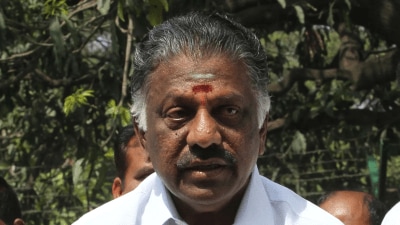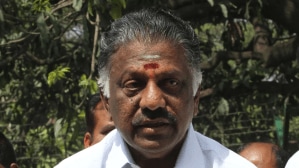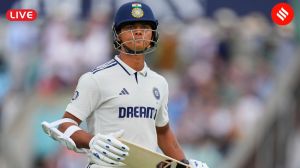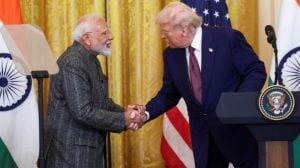Solving Crime: When tale spun by a murder accused sent CBI on a wild goose chase and put a Bengaluru cop in the dock for years
After the murder of IT professional Payal Surekha in Dec 2010, the police quickly zeroed in on the accused James Ray, a gym trainer. Little did the investigators suspect that he would turn the tables on them, forcing the cops to prove their innocence instead.
 Payal Surekha and James Ray. (Express Photo)
Payal Surekha and James Ray. (Express Photo) It was December 2010 and Umesh S K, the then inspector of J P Nagar police station in Bengaluru, was in a relaxed frame of mind as his team had just managed to crack the murder of a 29-year-old woman. What he did not know was that in a curious twist of fate, the CBI lens would soon be on him and a question mark would loom over his integrity for years because of one lie that the accused had managed to cook up.
The brutal murder of senior software professional Payal Surekha on December 17, 2010 came as a shock to her family and friends, but the police were quick to arrest the accused James Ray, a gym trainer. Little did the investigators suspect that the accused would turn the tables on them, forcing the police officers to prove to the CBI that the evidence in the case was not fabricated. It eventually took nine years for a court to uphold the investigation by the Bengaluru police and clear the officers’ names.
Love blooms in Bengaluru
Assam native Payal Surekha met Ananth Narayan Mishra, who hails from Odisha, in 2002 when they both arrived in Bengaluru and became classmates in the city’s AMC College. A live-in relationship ensued. Both of them completed their MBA and tied the knot in June 2007 despite opposition from their families. Post-marriage, Payal stayed with her in-laws in Cuttack and soon gained their trust and love.
Ananth’s father Rudra Narayan Mishra, then an additional superintendent of police with the Criminal Investigation Department (CID) in Cuttack, entrusted Payal with the responsibility of taking care of the family’s finances. In 2010, however, Payal shifted to Bengaluru after she got a job with Dell. Ananth Mishra had established a gymnasium in the city. He also owned a gym in Cuttack.
‘Murder for revenge’
On the fateful day, Ananth was in his hometown and he tried calling Payal, but was unable to reach her. Concerned, he asked the landlord to check on her. When the landlord entered the apartment using a spare key, Payal’s lifeless body was spotted lying in a pool of blood.
Sharing details of the case, Umesh said, “I was deputed for security at a local temple festival that day and was totally tired when I heard the news, but you know, we could not stop till we got a lead in the murder case.”
“When I reached the spot, I found that Payal was murdered brutally. Her throat was slit and there were multiple wounds on her body. Prima facie, it looked like the motive was personal revenge and not murder for gain,” he recounted.
“We collected hair samples from various rooms and other evidence. Naturally, Ananth Mishra was our first suspect but when we subjected him to questioning, it was clear he did not have any role in it. Later, we asked him about others with whom Payal had issues. One of the names that came up was that of James Kumar Ray, an Odisha native and son of a police officer who worked as a gym trainer. Payal had sacked him for misappropriating funds and misbehaving with women,” he added.
 Umesh S K went on to retire from the force as a Deputy Superintendent of Police (DSP)
Umesh S K went on to retire from the force as a Deputy Superintendent of Police (DSP)
The JP Nagar police obtained James Ray’s call records which revealed his presence in the area at the time of the murder. The police managed to arrest James Ray and during interrogation, he confessed to the murder and revealed the motive behind it.
Siphoning off funds, misbehaviour
James had previously worked at a gym owned by Ananth Mishra and Payal in Cuttack. Payal had fired him in 2008 after he allegedly siphoned money from the gym. There were also some complaints from women that James had misbehaved with them. After Payal informed the matter to Ananth, the latter fired James with a severance pay of Rs 75,000.
James then moved to Hyderabad with his family, but remained unemployed. In November 2010, he contacted Bhavani Shankar, who was also Ananth’s friend, and sought assistance in finding a job.
Bhavani promised to help him and said he would speak to Ananth about potential job openings. On December 11, 2010, James travelled to Bengaluru to meet Bhavani and the two reached Ananth’s residence. However, Payal reprimanded Bhavani for bringing James to their home and refused to help.
A vengeful James returned to Hyderabad and decided to kill Payal, the police said. He boarded a bus to Bengaluru on the night of December 16 and arrived at her residence around 10 am the next day. A resident of the building, Munavar Ali, saw James entering Payal’s house. “Though he knew Payal’s house, James asked Munavar Ali for the address when he encountered him and Munavar’s statement became crucial in court,” recalled Umesh.
James was apprehended in Hyderabad on December 22, 2010. The police soon discovered a jacket stained with blood and hair, a knife and spectacles in the catchment area of Puttenahalli Lake. Payal’s DNA was detected on the hair and blood on the jacket, and the blood on the knife too matched. Additionally, the hairs found on Payal’s body and the bedsheet in her room matched James’s DNA.
James spins a new tale
Approximately one week after James was remanded in judicial custody, Payal’s father Dindayal Surekha received a letter from him. On opening the envelope, Dindayal found a handwritten letter from James accompanied by what appeared to be call records belonging to Ananth Mishra.
According to Umesh, James had fabricated the call record details such that it indicated Ananth’s presence in Bengaluru on the morning of Payal’s murder. It also showed that he had travelled to Cuttack later. James claimed in the letter that the police had tortured him and coerced him into confessing to Payal’s murder.
“On December 23, when we brought James from Andhra Pradesh to Bengaluru, the victim’s father wanted to speak to him while he was in the police lock-up. We allowed it. In the letter, James had told Dindayal that he could not discuss the matter in detail at the police station due to fear. He accused me of planting evidence and framing him, alleging that I was protecting Ananth because his parents were former police officers. This was the first time I faced accusations of mishandling an investigation, and it put my career on the line,” Umesh said.
Coincidentally, Payal’s sister had a fallout with Ananth a couple of months prior to the murder. She too contacted Dindayal, informing him that Ananth had threatened to kill Payal.
Cop turns suspect
In January 2011, Payal’s parents and James approached the Karnataka High Court seeking a CBI investigation into the case. The high court directed the Central Crime Branch to conduct the probe. When the CCB inquiry reached a stalemate, Dindayal petitioned the high court once again for a CBI probe. In November 2011, the central agency took over the case and spent a year scrutinising Umesh S K.
The initial premise of the CBI probe was that James was innocent, Umesh remembered. For an entire year, the CBI team investigated the officer’s association with Ananth and his parents Rudra Narayana Mishra and Basanthi Devi Narayana Mishra, who were both police officers.
“The CBI strongly believed that I had planted evidence and coerced a confession from James. They examined my finances, Call Detail Records (CDR), and tracked my movements. For a whole year, I was constantly under surveillance and investigation. It was disheartening. I had an airtight case with solid evidence, yet I was the one treated as a suspect,” Umesh shared.
“By 2013, James Ray had approached the Odisha Human Rights Commission and filed a case against us claiming that we had humiliated him by arresting him with fabricated evidence. The commission also ordered a compensation of Rs 1 lakh which the state government paid to him then. We were stunned by his petition and the order.”
Forensic analysis proves key
After a year of investigation that yielded no progress, the case was transferred to a second CBI team. It was at this point that investigators finally began to focus on James as the primary suspect. “There was no other line of inquiry that the CBI could pursue. All the evidence pointed to James. Finally, they decided to have the samples and evidence examined at the Forensic Science Laboratory (FSL) in Hyderabad. The results confirmed what I had maintained all along. They found that the call record document James had sent to Dindayal was fabricated,” Umesh said.
“One of the witnesses (during spot mahazar) in the case was Raghu Gowda who lived close to Payal’s house. It was a mistake on our part that we did not collect his native address. Unable to produce him, the CBI contended that Raghu Gowda was a fictitious person. I took a week’s leave and went to Mumbai to track him as we got information that he was working in a live band. Though I could not trace him, he got to know of it and reached out to us. When we produced him before the CBI, it was a big relief,” he said.
Vindicated
In August 2015, the CBI filed a chargesheet naming James as the prime accused. “I felt vindicated. The CBI’s chargesheet mirrored the one I had submitted to the sessions court. They used the same witnesses. I still remember taking Munavar Ali (the neighbour) to prison. We had arranged a line-up of 22 individuals and he identified James as the man he had seen on the day of the murder. The CBI also included him as a witness. After five years, everything in the case remained unchanged,” Umesh asserted.
 Police officer Umesh S K with his daughter and film actress Sapthami Gowda on the day of his retirement. (Express Photo)
Police officer Umesh S K with his daughter and film actress Sapthami Gowda on the day of his retirement. (Express Photo)
In November 2019, the special court for CBI cases in Bengaluru sentenced James Ray to life imprisonment and imposed a fine of Rs 1 lakh. The court accepted that the murder was not carried out due to a sudden provocation but was pre-planned, and refuted the defence’s arguments. When there was no direct evidence of the crime, the court said in the order, “Man may tell a lie, but the circumstances would not tell a lie”.
Umesh went on to retire from the force with a Deputy Superintendent of Police (DSP) rank. His only woe? The pending CBI inquiry meant that despite being eligible, the officer missed out on the coveted President’s Medal for meritorious service.












